-
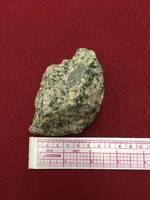 Granodiorite:R-152
Granodiorite:R-152 This hand sample of Granodiorite was found at Nantasket Beach, Massachusetts by Ralph Digman on October 16, 1949. The sample number is R-152 and belongs to the Department of Geology at Lafayette College.
This Granodiorite hand sample is a coarse grained intrusive igneous rock which means that it slowly cooled deep underground in a magma chamber (pluton) Its looks to be composed mostly of Quartz, Plagioclase and Alkali Feldspar but also looks like it could have a few biotite and hornblende crystals in it as well. One very possible composition percentage for this rock specimen would be about 60% Plagioclase, 15% Alkali, and 25% Quartz. This rock specimen has obvious phaneritic texture and kinda looks like it could be Granite. However, Granodiorite rocks have more Plagioclase and dark minerals than Granites. This Granodiorite hand sample is white, green, and black in color.
-
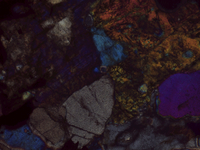 2015-CTP-5
2015-CTP-5 Hand Sample: Right away, it is obvious that this specimen contains garnet, biotite, and quartz. There is also an unknown yellow-ish large grained mineral seen, but is unidentifiable. There is some foliation, but not much.
Thin Section: Unfortunately, garnet is not visible in thin section. However, biotite and quartz are abundant. Some plagioclase and few other trace minerals. Due some issues with grinding the rock, some minerals are cracked along their cleavage.
This rock could be called a garnet, biotite schist. The protolith of this rock would have been slate, shale and even sediment. Under high pressures and temperatures, it would have have to been compressed int a gneiss. his could have occurred because of an orogenic event or something like it.
-
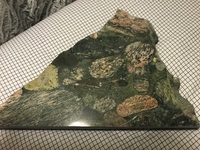 2015-CTP-11
2015-CTP-11 Meta-Conclomerate
Hand Specimen
Conglomerate protolith that underwent metamorphism
Clasts deformed from initial metamorphism of source rock
-followed by erosion & high energy deposition (given large clast size)
-matrix of sand appears green (Fig. 1)
-cement matrix not as strong as clasts, breaks easier around clasts (Fig. 2)
-clasts appear to be oval shaped which could have been caused by metamorphism deformation
Entire sample metamorphosed
-large clasts in granite have been previously metamorphosed as well
-green matrix/groundmass consists of a dark sand, probably fairly close to a volcanic source
Composition (Hand Specimen)
Entire sample is metamorphosed and composed of about 60% pebble and 40% matrix (Fig. 3)
-large clasts appear to consist of quartz, plagioclase feldspar and pink feldspars)
-interstitial small tiny grains invisible to naked eye appear greenish-black
Though some clasts break around weaker cement, less strong clasts may crack due to pressure during metamorphism, as seen in plain light thin section with light coming through the glass (Fig. 4) and in cross polarization the cracked/split area being black due to glass go slide being isotropic (Fig. 5).
Thin Section (Numbers correlate to Fig. 6)
1) Large clast appears high deformed by metamorphism on slide. (Metamorphosed Twice).
-microscopically appears black and white indicative of plagioclase feldspar microlites under cross polarized light (Fig. 7) with dark brown garnet under XPL and PPL (Fig. 8).
-25x magnification of garnet in PPL seen as a yellowish maroon-brown color (Fig. 9) and under XPL is a black center with dark brown surrounding it (Fig. 10).
-garnet indicates medium to high grade metamorphism after
clast is metamorphosed twice, at the corresponding temperature and pressure (500-650C and 5-7kbars).
2)Clast appears black with large light colored grains within it on thin section. (Metamorphosed Twice).
-Porphyroblast: large crystal in metamorphosed rock that has grown much more than finer grained groundmass.
-PPL shows greenish groundmass suggesting epidote and a light colored euhedral crystal (Fig. 11).
-XPL makes groundmass a darker green and the euhedral crystal to a black-gray alternation due to extinction (Fig. 12).
3) Sandy matrix, appears green, black, and white on thin section, believed to be lithic origin constituting dark material and some larger white grains indicative of quartz and more weather resistant rocks. (Metamorphosed Once).
-Could not further grind slide due to other parts being too thin, but appears to have greenish fine matrix with colorless larger clasts in PPL (Fig. 13).
-In XPL (Fig. 14) matrix turns darker green and larger clasts show birefringence colors (sample still too thick), but, volcanic glass can be seen due to its isotropy (Fig. 15) supporting volcanics among the sandy matrix holding together the larger conglomerate clasts.
4) Large pink/black clast on thin section. (Twice Metamorphosed).
-In plain light there is alternating colorless and gray bands due to foliation caused by the pressure and temperature compressing the rock during metamorphism (Fig. 16).
-In the cross polarized light (Fig. 17) the bands that were colorless in plain light now have a high birefringence (this area of the slight not able to be thinned without sacrificing rest of slide). One grain begins to show twinning (orange/purple grain in lower center of Fig. 17 that shows cross hatching)
Story (Fig. 18)
Two plates colliding and forcing material upwards metamorphoses rock via regional metamorphism.
-large clasts broken off when uplifted and eroded as mountains rise during collision of plates.
-mountains form and become volcanically active from dewatering of subducting plate.
Volcanic rock extruded from volcanic arc along subduction zone—subsequent erosion of volcanics creates small mafic grains that are not very weather resistant.
-lithic sands fill interstitial matrix as erosion and deposition processes bury the alluvial fan in which large, metamorphosed pebble clasts were deposited when the mountains rose.
After volcanics and mountains rise and then come to a period of quiescence, the heavy continental crust of the uplifted mountain range may bow down on the lithosphere, allowing a large amount of deposition on top of the alluvial fan that was previously at a higher elevation and thus receiving less sedimentation from erosional processes.
-weight of added sediment as basin is fills up metamorphoses our conglomerate pebbles a second time (first time for the mafic/lithic sands making up the matrix) forming the sample we found.
-
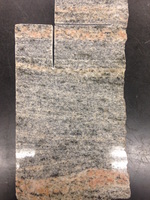 2015-CTP-1
2015-CTP-1 Based off of the association of minerals and textures presented in hand sample and thin section, this rock can be considered a Biotite Gneiss.
Hand sample contains a great majority of biotite crystals with interspersed felsic layer containing more potassium feldspar and quartz. Compositional layering is obvious and is an indicator of metamorphism.
Thin section displays brown, elongate crystals in polarized light which could be hornblende, but due to the Bird's eye texture and measure of the extinction angle of the crystals, we can confirm it is Biotite. In polarized light, there is a curtain surrounding the biotite grains indicating that the crystal is out of equilibrium with the melt. There also appears to be a great amount of clear material, which in cross-polarized light, is revealed as a mix of quartz and feldspar crystals which have lower interference figures.
-
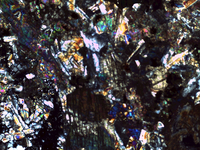 RR10
RR10
-
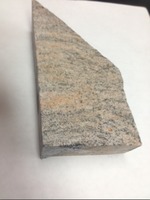 2015-CTP-14: Metamorphic Rock Lab
2015-CTP-14: Metamorphic Rock Lab This rock was found from the counter top company in Easton, PA. The structure of the rock depicts likely low to intermediate grade metamorphism. Inclusions of biotite describe a likely regional metamorphism at lower to intermediate grades. Other possible inclusions of chlorite also indicate probable low grades of metamorphism. Inclusions of plagioclase crystals and quartz are also visible but do not support in determining a specific grade or setting of metamorphism. Due to the sample being taken from the counter top company, an origin of the sample is unable to be determined.
-
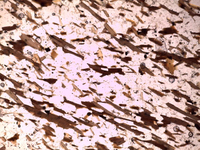 2015-CPT-9
2015-CPT-9 Metamorphic rock taken from counter top company. The hand sample in black in color with veins of quartz. There are garnets visible as well. In thin section, the minerals are quartz, plagioclase, garnet, and biotite.
-
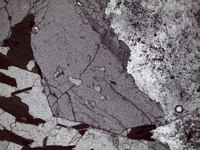 2015-CTP-15
2015-CTP-15 A garnet biotite schist from the Philipsburg Marble Comp. trash pile.
-
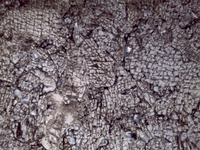 2015-CTP-13: Garnet Granulite
2015-CTP-13: Garnet Granulite The hand sample is mostly made of light-colored fine grains. There are some large garnet porphryoblasts. There is some very subtle lineation of dark colored minerals, possibly biotite, that form streaks. The thin section is made of large xenoblastic grains of mostly quartz, plagioclase feldspar that exhibits lamellar twinning, and some potassium feldspar evidenced by grid twinning. The texture of some these large grains looks to be granular and made of smaller equi-dimensional grains. There is random orientation and no foliation indicating a decussate texture. There were a large amount of garnet poikiloblasts at the top of the thin section but grinding unfortunately removed these grains. There appears to be a very small piece of garnet left behind but its optical properties seems to have been disrupted by being broken up. Also, there are a few grains that appear to exhibit undulose extinction. There could be possibly be a few kyanite grains.
-
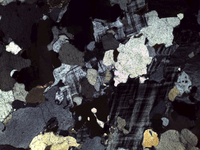 Kojaian CTP
Kojaian CTP This rock contains quartz, plagioclase, garnet and chlorite. These minerals can be seen in the thin section photos. Given the mineral assemblage, I think the rock experienced intermediate grade metamorphism. The chlorite may have developed as a result of retrograde metamorphism.
-
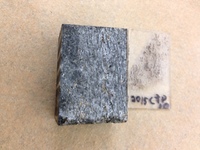 CTP-10-2015, Biotite Schist, Dustin Morris
CTP-10-2015, Biotite Schist, Dustin Morris This is a metamorphic rocks that is foliated and has large platey grains, easily visible to the naked eye.
In hand sample the foliation is readily visible and the black plately minerals can be identified as biotite. There are also gray/white mineral grains that can't be identified in hand sample.
In thin section it is easily to identify the biotite grains with their brown color, distinct cleavage, parallel extinction, and medium interference colors. It is also easy to see the foliation of the biotite grains in thin section. The white grains are colorless in plain light and have distinct 90 degree cleavage. In cross-polarized light we can see that these minerals have low interference colors, therefore we can confidentially say that they are plagioclase.
A rock that is foliated and has large platey grains, visible to the naked eye is considered a schist. The dominance of biotite means that it is worth making the distinction that this a biotite schist. This would be a medium to high grade metamorphic rock. As a schist the protolith would likely have been a shale that was metamorphosed into a slate and phyllite before becoming a schist. However being dominantly biotite means the clay minerals of the shale may have been more rich in Fe and Mg than the shales that would make the more common muscovite schists.
-
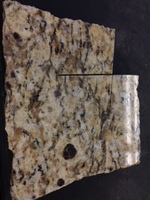 2015-CTP-17 Garnet-Biotite-Muscovite Gneiss
2015-CTP-17 Garnet-Biotite-Muscovite Gneiss Hand-Sample: A garnet-rich micaceous, tan-white gneiss with black banding
-
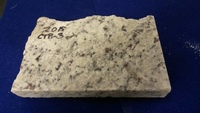 2015-CTP-3 Garnet-Biotite Gneiss
2015-CTP-3 Garnet-Biotite Gneiss Hand Sample: Coarse, idiobastic garnet and biotite grains with coarse xenoblastic plagioclase and quartz crystals. Foliation is visible with the alignment of the biotite crystals, and gneissic banding is present between the quartz and plagioclase crystals.Thin Section: Coarse xenoblastic grains of plagioclase and quartz present, with idioblastic, poikiloblastic garnets with plagioclase and biotite inclusions. There are some foliated biotite crystals, but the foliation is only easily seen in in hand sample. There are some small perthite crystals inbetween the larger crystals.
-
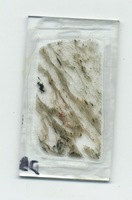 2015-CTP-2
2015-CTP-2 This metamorphic rock contains a wide array of minerals. When looking at the hand sample, there are visible sheet silicates that appear to be muscovite. Under a thin section, there appears to be quartz, plagioclase feldspar, and red minerals that are possibly pyroxenes. The high birefringence minerals within the thin section seem to be muscovites. When looking at the side of the hand sample, there is schistosity, suggesting that this rock is a muscovite schist.
-
 Aegean Arc
Aegean Arc
-
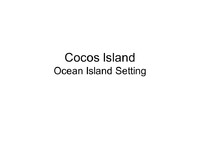 Cocos Island
Cocos Island
-
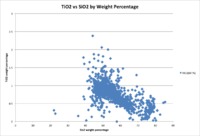 Convergent Setting: Lesser Antilles
Convergent Setting: Lesser Antilles Geochemical Plots for the Lesser Antilles. Includes REE plot, ternary diagram, and multiple Harker diagrams. Some files contain more detailed interpretations and explanations for the data.
In general the harper diagrams reveal that K, Na, and Al remain as a liquid until later stages of the melts crystallization, as indicative by increasing weight percentages occurring coeval to increasing weight percentages of the control SiO2 group.
In contrast, Fe, Ca, Ti, and P2O5 decrease in weight percentage as the melt progresses, as expected for elements with higher electronegativity and smaller atomic radii.
The shape of the alkali vs SiO2 graph is similar to that of the alkali vs SiO2 graph for the Cascade Volcanic Arc, which is in fact expected for most melts in the world, due to the incompatibility of alkalis, but what is particularly interesting is the similarity of the spread of the data in both cases.
-
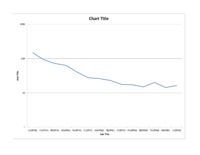 Convergent magma generation - Claire, Hana, Ryan
Convergent magma generation - Claire, Hana, Ryan Magma is generated in a similar fashion at all three convergent margin localities. At the Andean Arc and the Trans-Mexican Volcanic Belt magma is generated because the subducting slabs begin to dehydrate and release water into the surrounding mantle rocks. This addition of water lowers the melting temperature of the mantle and allows for melting to take place. However, in the Trans-Mexican Volcanic Belt decompression melting also occurs. The melt at continental subduction zone arcs produces rhyolitic or andesitic rocks. Rhyolite and andesite are produced because as the magma works its way through the mantle and crust it fractionally crystallizes. This helps to remove some of the mafic minerals. Also, as the melt moves through the granitic continental crust, some of the crust is assimilated into the melt. Both of these processes help to make the magma more felsic. The Solomon Islands were created through subduction as well, however, the Solomon Islands are an island arc, not a continental arc. This means that they were created on an overriding oceanic plate, not a continental plate. Since the magma that created the arc did not have to travel through continental crust, it was unable to assimilate more felsic magma into its composition, therefore at the rocks are more mafic than rocks at the Andean Arc or Trans-Mexican Volcanic Belt. Rocks from the Solomon Islands are high in sodic and alkaline minerals.
Picture from
Winter, J. D. (n.d.). Igneous and Metamorphic Petrology Class Material.
Retrieved May 6, 2015, from https://www.whitman.edu/geology/winter/
JDW_PetClass.htm
-
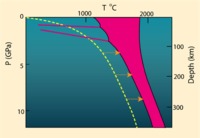 Convergent Magma generation - Claire, Hana, Ryan
Convergent Magma generation - Claire, Hana, Ryan Magma is generated in a similar fashion at all three convergent margin localities. At the Andean Arc and the Trans-Mexican Volcanic Belt magma is generated because the subducting slabs begin to dehydrate and release water into the surrounding mantle rocks. This addition of water lowers the melting temperature of the mantle and allows for melting to take place. However, in the Trans-Mexican Volcanic Belt decompression melting also occurs. The melt at continental subduction zone arcs produces rhyolitic or andesitic rocks. Rhyolite and andesite are produced because as the magma works its way through the mantle and crust it fractionally crystallizes. This helps to remove some of the mafic minerals. Also, as the melt moves through the granitic continental crust, some of the crust is assimilated into the melt. Both of these processes help to make the magma more felsic. The Solomon Islands were created through subduction as well, however, the Solomon Islands are an island arc, not a continental arc. This means that they were created on an overriding oceanic plate, not a continental plate. Since the magma that created the arc did not have to travel through continental crust, it was unable to assimilate more felsic magma into its composition, therefore at the rocks are more mafic than rocks at the Andean Arc or Trans-Mexican Volcanic Belt. Rocks from the Solomon Islands are high in sodic and alkaline minerals.
Picture from
Winter, J. D. (n.d.). Igneous and Metamorphic Petrology Class Material.
Retrieved May 6, 2015, from https://www.whitman.edu/geology/winter/
JDW_PetClass.htm
-
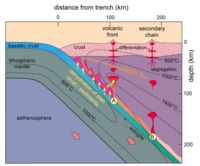 Convergent Landforms - Claire Hana Ryan
Convergent Landforms - Claire Hana Ryan Landforms that occur in convergent margins result from subducting denser, older tectonic plates beneath a younger and less dense tectonic plate. This can occur between both oceanic-oceanic convergent margins, as well as oceanic-continental convergent margins. The convergent margins that are currently being compared, comprise one oceanic-oceanic convergent margins(Solomon Island Arc), and two oceanic-continental margin (Trans-Mexican Volcanic belt and the Andean Arc). The landforms that result between the two types of convergence differ, but also have similarities. The Trans-Mexican Volcanic belt and Andean Arc has caused stratovolcanoes to occur along the continental plate, due to the oceanic plate being older and denser and therefor subducting. This has resulted in diverse magma compositions in the Trans-Mexican Volcanic belt and the Andean Arc, but dominantly rocks of calc-alkaline composition. Within the Andean Arc, it is likely that the resulting rocks that occur within the region are andesitic. This is likely due to the increased silicic composition of the continental plate that the magma assimilates through from the mantle. The other convergent margin system, Solomon Island Arc, is oceanic-oceanic convergence, still resulting in an older and denser plate to become subducted. This subducting plate also results in stratovolcanoes, however the composition of the resulting magma is often less rich in silica and calcium elements due to assimilation through another oceanic plate. This results in island arc building that is considered to be MORB like in composition, or rich in basaltic rocks.
Picture from
Winter, J. D. (n.d.). Igneous and Metamorphic Petrology Class Material.
Retrieved May 6, 2015, from https://www.whitman.edu/geology/winter/
JDW_PetClass.htm
-
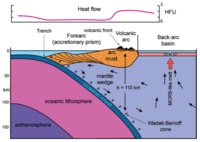 Convergent Margin Comparison - Tectonic Setting
Kojaian, Isihara and Sanders
Convergent Margin Comparison - Tectonic Setting
Kojaian, Isihara and Sanders The Solomon Islands, the Andean Arc and the Trans-Mexican Volcanic Belt are all similar in the sense that they are all subduction related arcs. The Andean Arc and the Trans-Mexican Volcanic Belt are both continental arcs. This means that they were formed by an oceanic plate subducting under a continental plate. In this case, the volcanic arc is created on top of the continent. Alternatively, the Solomon Islands were created by an island arc. This means that oceanic crust (the Solomon Sea Plate, Woodlark Plate and the Australian Plate) are subducting underneath other ocean crust (the Pacific Plate). This happens because the subducting plates are older, colder and more dense than the overriding plates.
Picture from
Winter, J. D. (n.d.). Igneous and Metamorphic Petrology Class Material.
Retrieved May 6, 2015, from https://www.whitman.edu/geology/winter/
JDW_PetClass.htm
-
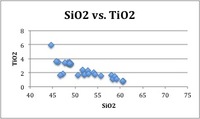 Cocos Island: Geochemistry
Cocos Island: Geochemistry
-
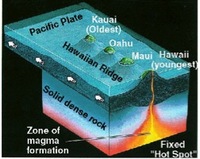 Cocos Island: Magma generating processes
Cocos Island: Magma generating processes The Cocos Island likely formed due to a hotspot beneath the Cocos plate. A submarine volcano produced the ocean island, due to a hotspot of solid magma eventually producing an island landmass with an elevation sea level. This is typical from a hotspot where magma comes from the core-mantle boundary and rise toward the oceanic plate. The figure describes a hotspot magma generating process, but describes events that occurred to form Hawaii.
-
 Cocos Island: Landforms
Cocos Island: Landforms The Cocos Island originated as a chain of islands, similar to the Galapagos Islands. The Cocos ridge is ~1000km long, ~200km wide, and has elevations no higher than 1000meters. Which makes it a very low elevation landform beneath the pacific ocean. Its north-east trend of 45 degrees is similar to the strike of the Middle America Trench, along which it is being subducted off Costa Rica and Panama continental plates. The island landform likely formed from a submarine volcano with a max elevation of 634 meters. The strata is composed of solid lava, which has soils that are now highly acidic and fragile.
-
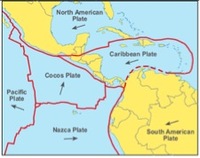 Cocos Island: Tectonic-magmatic setting
Cocos Island: Tectonic-magmatic setting This setting is located on an intraplate margin, more specifically in the middle of the Cocos plate, in the Pacific Ocean. The plate was created by sea floor spreading along the East Pacific Rise and the Cocos Ridge. The northern boundary of the plate is the middle America Trench. The eastern boundary is the Panama fracture zone, which is a transform fault setting. The southern boundary of the Cocos plate is and oceanic spreading ridge called the Galapagos Rise. The western boundary is another oceanic ridge called the East Pacific Rise, in the Pacific Ocean. Overall the Cocos plate is moving north-eastward and subducting under the Carribean plate, which is due to the Carribean plate being older and denser.
 Granodiorite:R-152 This hand sample of Granodiorite was found at Nantasket Beach, Massachusetts by Ralph Digman on October 16, 1949. The sample number is R-152 and belongs to the Department of Geology at Lafayette College. This Granodiorite hand sample is a coarse grained intrusive igneous rock which means that it slowly cooled deep underground in a magma chamber (pluton) Its looks to be composed mostly of Quartz, Plagioclase and Alkali Feldspar but also looks like it could have a few biotite and hornblende crystals in it as well. One very possible composition percentage for this rock specimen would be about 60% Plagioclase, 15% Alkali, and 25% Quartz. This rock specimen has obvious phaneritic texture and kinda looks like it could be Granite. However, Granodiorite rocks have more Plagioclase and dark minerals than Granites. This Granodiorite hand sample is white, green, and black in color.
Granodiorite:R-152 This hand sample of Granodiorite was found at Nantasket Beach, Massachusetts by Ralph Digman on October 16, 1949. The sample number is R-152 and belongs to the Department of Geology at Lafayette College. This Granodiorite hand sample is a coarse grained intrusive igneous rock which means that it slowly cooled deep underground in a magma chamber (pluton) Its looks to be composed mostly of Quartz, Plagioclase and Alkali Feldspar but also looks like it could have a few biotite and hornblende crystals in it as well. One very possible composition percentage for this rock specimen would be about 60% Plagioclase, 15% Alkali, and 25% Quartz. This rock specimen has obvious phaneritic texture and kinda looks like it could be Granite. However, Granodiorite rocks have more Plagioclase and dark minerals than Granites. This Granodiorite hand sample is white, green, and black in color. 2015-CTP-5 Hand Sample: Right away, it is obvious that this specimen contains garnet, biotite, and quartz. There is also an unknown yellow-ish large grained mineral seen, but is unidentifiable. There is some foliation, but not much. Thin Section: Unfortunately, garnet is not visible in thin section. However, biotite and quartz are abundant. Some plagioclase and few other trace minerals. Due some issues with grinding the rock, some minerals are cracked along their cleavage. This rock could be called a garnet, biotite schist. The protolith of this rock would have been slate, shale and even sediment. Under high pressures and temperatures, it would have have to been compressed int a gneiss. his could have occurred because of an orogenic event or something like it.
2015-CTP-5 Hand Sample: Right away, it is obvious that this specimen contains garnet, biotite, and quartz. There is also an unknown yellow-ish large grained mineral seen, but is unidentifiable. There is some foliation, but not much. Thin Section: Unfortunately, garnet is not visible in thin section. However, biotite and quartz are abundant. Some plagioclase and few other trace minerals. Due some issues with grinding the rock, some minerals are cracked along their cleavage. This rock could be called a garnet, biotite schist. The protolith of this rock would have been slate, shale and even sediment. Under high pressures and temperatures, it would have have to been compressed int a gneiss. his could have occurred because of an orogenic event or something like it. 2015-CTP-11 Meta-Conclomerate Hand Specimen Conglomerate protolith that underwent metamorphism Clasts deformed from initial metamorphism of source rock -followed by erosion & high energy deposition (given large clast size) -matrix of sand appears green (Fig. 1) -cement matrix not as strong as clasts, breaks easier around clasts (Fig. 2) -clasts appear to be oval shaped which could have been caused by metamorphism deformation Entire sample metamorphosed -large clasts in granite have been previously metamorphosed as well -green matrix/groundmass consists of a dark sand, probably fairly close to a volcanic source Composition (Hand Specimen) Entire sample is metamorphosed and composed of about 60% pebble and 40% matrix (Fig. 3) -large clasts appear to consist of quartz, plagioclase feldspar and pink feldspars) -interstitial small tiny grains invisible to naked eye appear greenish-black Though some clasts break around weaker cement, less strong clasts may crack due to pressure during metamorphism, as seen in plain light thin section with light coming through the glass (Fig. 4) and in cross polarization the cracked/split area being black due to glass go slide being isotropic (Fig. 5). Thin Section (Numbers correlate to Fig. 6) 1) Large clast appears high deformed by metamorphism on slide. (Metamorphosed Twice). -microscopically appears black and white indicative of plagioclase feldspar microlites under cross polarized light (Fig. 7) with dark brown garnet under XPL and PPL (Fig. 8). -25x magnification of garnet in PPL seen as a yellowish maroon-brown color (Fig. 9) and under XPL is a black center with dark brown surrounding it (Fig. 10). -garnet indicates medium to high grade metamorphism after clast is metamorphosed twice, at the corresponding temperature and pressure (500-650C and 5-7kbars). 2)Clast appears black with large light colored grains within it on thin section. (Metamorphosed Twice). -Porphyroblast: large crystal in metamorphosed rock that has grown much more than finer grained groundmass. -PPL shows greenish groundmass suggesting epidote and a light colored euhedral crystal (Fig. 11). -XPL makes groundmass a darker green and the euhedral crystal to a black-gray alternation due to extinction (Fig. 12). 3) Sandy matrix, appears green, black, and white on thin section, believed to be lithic origin constituting dark material and some larger white grains indicative of quartz and more weather resistant rocks. (Metamorphosed Once). -Could not further grind slide due to other parts being too thin, but appears to have greenish fine matrix with colorless larger clasts in PPL (Fig. 13). -In XPL (Fig. 14) matrix turns darker green and larger clasts show birefringence colors (sample still too thick), but, volcanic glass can be seen due to its isotropy (Fig. 15) supporting volcanics among the sandy matrix holding together the larger conglomerate clasts. 4) Large pink/black clast on thin section. (Twice Metamorphosed). -In plain light there is alternating colorless and gray bands due to foliation caused by the pressure and temperature compressing the rock during metamorphism (Fig. 16). -In the cross polarized light (Fig. 17) the bands that were colorless in plain light now have a high birefringence (this area of the slight not able to be thinned without sacrificing rest of slide). One grain begins to show twinning (orange/purple grain in lower center of Fig. 17 that shows cross hatching) Story (Fig. 18) Two plates colliding and forcing material upwards metamorphoses rock via regional metamorphism. -large clasts broken off when uplifted and eroded as mountains rise during collision of plates. -mountains form and become volcanically active from dewatering of subducting plate. Volcanic rock extruded from volcanic arc along subduction zone—subsequent erosion of volcanics creates small mafic grains that are not very weather resistant. -lithic sands fill interstitial matrix as erosion and deposition processes bury the alluvial fan in which large, metamorphosed pebble clasts were deposited when the mountains rose. After volcanics and mountains rise and then come to a period of quiescence, the heavy continental crust of the uplifted mountain range may bow down on the lithosphere, allowing a large amount of deposition on top of the alluvial fan that was previously at a higher elevation and thus receiving less sedimentation from erosional processes. -weight of added sediment as basin is fills up metamorphoses our conglomerate pebbles a second time (first time for the mafic/lithic sands making up the matrix) forming the sample we found.
2015-CTP-11 Meta-Conclomerate Hand Specimen Conglomerate protolith that underwent metamorphism Clasts deformed from initial metamorphism of source rock -followed by erosion & high energy deposition (given large clast size) -matrix of sand appears green (Fig. 1) -cement matrix not as strong as clasts, breaks easier around clasts (Fig. 2) -clasts appear to be oval shaped which could have been caused by metamorphism deformation Entire sample metamorphosed -large clasts in granite have been previously metamorphosed as well -green matrix/groundmass consists of a dark sand, probably fairly close to a volcanic source Composition (Hand Specimen) Entire sample is metamorphosed and composed of about 60% pebble and 40% matrix (Fig. 3) -large clasts appear to consist of quartz, plagioclase feldspar and pink feldspars) -interstitial small tiny grains invisible to naked eye appear greenish-black Though some clasts break around weaker cement, less strong clasts may crack due to pressure during metamorphism, as seen in plain light thin section with light coming through the glass (Fig. 4) and in cross polarization the cracked/split area being black due to glass go slide being isotropic (Fig. 5). Thin Section (Numbers correlate to Fig. 6) 1) Large clast appears high deformed by metamorphism on slide. (Metamorphosed Twice). -microscopically appears black and white indicative of plagioclase feldspar microlites under cross polarized light (Fig. 7) with dark brown garnet under XPL and PPL (Fig. 8). -25x magnification of garnet in PPL seen as a yellowish maroon-brown color (Fig. 9) and under XPL is a black center with dark brown surrounding it (Fig. 10). -garnet indicates medium to high grade metamorphism after clast is metamorphosed twice, at the corresponding temperature and pressure (500-650C and 5-7kbars). 2)Clast appears black with large light colored grains within it on thin section. (Metamorphosed Twice). -Porphyroblast: large crystal in metamorphosed rock that has grown much more than finer grained groundmass. -PPL shows greenish groundmass suggesting epidote and a light colored euhedral crystal (Fig. 11). -XPL makes groundmass a darker green and the euhedral crystal to a black-gray alternation due to extinction (Fig. 12). 3) Sandy matrix, appears green, black, and white on thin section, believed to be lithic origin constituting dark material and some larger white grains indicative of quartz and more weather resistant rocks. (Metamorphosed Once). -Could not further grind slide due to other parts being too thin, but appears to have greenish fine matrix with colorless larger clasts in PPL (Fig. 13). -In XPL (Fig. 14) matrix turns darker green and larger clasts show birefringence colors (sample still too thick), but, volcanic glass can be seen due to its isotropy (Fig. 15) supporting volcanics among the sandy matrix holding together the larger conglomerate clasts. 4) Large pink/black clast on thin section. (Twice Metamorphosed). -In plain light there is alternating colorless and gray bands due to foliation caused by the pressure and temperature compressing the rock during metamorphism (Fig. 16). -In the cross polarized light (Fig. 17) the bands that were colorless in plain light now have a high birefringence (this area of the slight not able to be thinned without sacrificing rest of slide). One grain begins to show twinning (orange/purple grain in lower center of Fig. 17 that shows cross hatching) Story (Fig. 18) Two plates colliding and forcing material upwards metamorphoses rock via regional metamorphism. -large clasts broken off when uplifted and eroded as mountains rise during collision of plates. -mountains form and become volcanically active from dewatering of subducting plate. Volcanic rock extruded from volcanic arc along subduction zone—subsequent erosion of volcanics creates small mafic grains that are not very weather resistant. -lithic sands fill interstitial matrix as erosion and deposition processes bury the alluvial fan in which large, metamorphosed pebble clasts were deposited when the mountains rose. After volcanics and mountains rise and then come to a period of quiescence, the heavy continental crust of the uplifted mountain range may bow down on the lithosphere, allowing a large amount of deposition on top of the alluvial fan that was previously at a higher elevation and thus receiving less sedimentation from erosional processes. -weight of added sediment as basin is fills up metamorphoses our conglomerate pebbles a second time (first time for the mafic/lithic sands making up the matrix) forming the sample we found. 2015-CTP-1 Based off of the association of minerals and textures presented in hand sample and thin section, this rock can be considered a Biotite Gneiss. Hand sample contains a great majority of biotite crystals with interspersed felsic layer containing more potassium feldspar and quartz. Compositional layering is obvious and is an indicator of metamorphism. Thin section displays brown, elongate crystals in polarized light which could be hornblende, but due to the Bird's eye texture and measure of the extinction angle of the crystals, we can confirm it is Biotite. In polarized light, there is a curtain surrounding the biotite grains indicating that the crystal is out of equilibrium with the melt. There also appears to be a great amount of clear material, which in cross-polarized light, is revealed as a mix of quartz and feldspar crystals which have lower interference figures.
2015-CTP-1 Based off of the association of minerals and textures presented in hand sample and thin section, this rock can be considered a Biotite Gneiss. Hand sample contains a great majority of biotite crystals with interspersed felsic layer containing more potassium feldspar and quartz. Compositional layering is obvious and is an indicator of metamorphism. Thin section displays brown, elongate crystals in polarized light which could be hornblende, but due to the Bird's eye texture and measure of the extinction angle of the crystals, we can confirm it is Biotite. In polarized light, there is a curtain surrounding the biotite grains indicating that the crystal is out of equilibrium with the melt. There also appears to be a great amount of clear material, which in cross-polarized light, is revealed as a mix of quartz and feldspar crystals which have lower interference figures. RR10
RR10  2015-CTP-14: Metamorphic Rock Lab This rock was found from the counter top company in Easton, PA. The structure of the rock depicts likely low to intermediate grade metamorphism. Inclusions of biotite describe a likely regional metamorphism at lower to intermediate grades. Other possible inclusions of chlorite also indicate probable low grades of metamorphism. Inclusions of plagioclase crystals and quartz are also visible but do not support in determining a specific grade or setting of metamorphism. Due to the sample being taken from the counter top company, an origin of the sample is unable to be determined.
2015-CTP-14: Metamorphic Rock Lab This rock was found from the counter top company in Easton, PA. The structure of the rock depicts likely low to intermediate grade metamorphism. Inclusions of biotite describe a likely regional metamorphism at lower to intermediate grades. Other possible inclusions of chlorite also indicate probable low grades of metamorphism. Inclusions of plagioclase crystals and quartz are also visible but do not support in determining a specific grade or setting of metamorphism. Due to the sample being taken from the counter top company, an origin of the sample is unable to be determined. 2015-CPT-9 Metamorphic rock taken from counter top company. The hand sample in black in color with veins of quartz. There are garnets visible as well. In thin section, the minerals are quartz, plagioclase, garnet, and biotite.
2015-CPT-9 Metamorphic rock taken from counter top company. The hand sample in black in color with veins of quartz. There are garnets visible as well. In thin section, the minerals are quartz, plagioclase, garnet, and biotite. 2015-CTP-15 A garnet biotite schist from the Philipsburg Marble Comp. trash pile.
2015-CTP-15 A garnet biotite schist from the Philipsburg Marble Comp. trash pile. 2015-CTP-13: Garnet Granulite The hand sample is mostly made of light-colored fine grains. There are some large garnet porphryoblasts. There is some very subtle lineation of dark colored minerals, possibly biotite, that form streaks. The thin section is made of large xenoblastic grains of mostly quartz, plagioclase feldspar that exhibits lamellar twinning, and some potassium feldspar evidenced by grid twinning. The texture of some these large grains looks to be granular and made of smaller equi-dimensional grains. There is random orientation and no foliation indicating a decussate texture. There were a large amount of garnet poikiloblasts at the top of the thin section but grinding unfortunately removed these grains. There appears to be a very small piece of garnet left behind but its optical properties seems to have been disrupted by being broken up. Also, there are a few grains that appear to exhibit undulose extinction. There could be possibly be a few kyanite grains.
2015-CTP-13: Garnet Granulite The hand sample is mostly made of light-colored fine grains. There are some large garnet porphryoblasts. There is some very subtle lineation of dark colored minerals, possibly biotite, that form streaks. The thin section is made of large xenoblastic grains of mostly quartz, plagioclase feldspar that exhibits lamellar twinning, and some potassium feldspar evidenced by grid twinning. The texture of some these large grains looks to be granular and made of smaller equi-dimensional grains. There is random orientation and no foliation indicating a decussate texture. There were a large amount of garnet poikiloblasts at the top of the thin section but grinding unfortunately removed these grains. There appears to be a very small piece of garnet left behind but its optical properties seems to have been disrupted by being broken up. Also, there are a few grains that appear to exhibit undulose extinction. There could be possibly be a few kyanite grains. Kojaian CTP This rock contains quartz, plagioclase, garnet and chlorite. These minerals can be seen in the thin section photos. Given the mineral assemblage, I think the rock experienced intermediate grade metamorphism. The chlorite may have developed as a result of retrograde metamorphism.
Kojaian CTP This rock contains quartz, plagioclase, garnet and chlorite. These minerals can be seen in the thin section photos. Given the mineral assemblage, I think the rock experienced intermediate grade metamorphism. The chlorite may have developed as a result of retrograde metamorphism. CTP-10-2015, Biotite Schist, Dustin Morris This is a metamorphic rocks that is foliated and has large platey grains, easily visible to the naked eye. In hand sample the foliation is readily visible and the black plately minerals can be identified as biotite. There are also gray/white mineral grains that can't be identified in hand sample. In thin section it is easily to identify the biotite grains with their brown color, distinct cleavage, parallel extinction, and medium interference colors. It is also easy to see the foliation of the biotite grains in thin section. The white grains are colorless in plain light and have distinct 90 degree cleavage. In cross-polarized light we can see that these minerals have low interference colors, therefore we can confidentially say that they are plagioclase. A rock that is foliated and has large platey grains, visible to the naked eye is considered a schist. The dominance of biotite means that it is worth making the distinction that this a biotite schist. This would be a medium to high grade metamorphic rock. As a schist the protolith would likely have been a shale that was metamorphosed into a slate and phyllite before becoming a schist. However being dominantly biotite means the clay minerals of the shale may have been more rich in Fe and Mg than the shales that would make the more common muscovite schists.
CTP-10-2015, Biotite Schist, Dustin Morris This is a metamorphic rocks that is foliated and has large platey grains, easily visible to the naked eye. In hand sample the foliation is readily visible and the black plately minerals can be identified as biotite. There are also gray/white mineral grains that can't be identified in hand sample. In thin section it is easily to identify the biotite grains with their brown color, distinct cleavage, parallel extinction, and medium interference colors. It is also easy to see the foliation of the biotite grains in thin section. The white grains are colorless in plain light and have distinct 90 degree cleavage. In cross-polarized light we can see that these minerals have low interference colors, therefore we can confidentially say that they are plagioclase. A rock that is foliated and has large platey grains, visible to the naked eye is considered a schist. The dominance of biotite means that it is worth making the distinction that this a biotite schist. This would be a medium to high grade metamorphic rock. As a schist the protolith would likely have been a shale that was metamorphosed into a slate and phyllite before becoming a schist. However being dominantly biotite means the clay minerals of the shale may have been more rich in Fe and Mg than the shales that would make the more common muscovite schists. 2015-CTP-17 Garnet-Biotite-Muscovite Gneiss Hand-Sample: A garnet-rich micaceous, tan-white gneiss with black banding
2015-CTP-17 Garnet-Biotite-Muscovite Gneiss Hand-Sample: A garnet-rich micaceous, tan-white gneiss with black banding 2015-CTP-3 Garnet-Biotite Gneiss Hand Sample: Coarse, idiobastic garnet and biotite grains with coarse xenoblastic plagioclase and quartz crystals. Foliation is visible with the alignment of the biotite crystals, and gneissic banding is present between the quartz and plagioclase crystals.Thin Section: Coarse xenoblastic grains of plagioclase and quartz present, with idioblastic, poikiloblastic garnets with plagioclase and biotite inclusions. There are some foliated biotite crystals, but the foliation is only easily seen in in hand sample. There are some small perthite crystals inbetween the larger crystals.
2015-CTP-3 Garnet-Biotite Gneiss Hand Sample: Coarse, idiobastic garnet and biotite grains with coarse xenoblastic plagioclase and quartz crystals. Foliation is visible with the alignment of the biotite crystals, and gneissic banding is present between the quartz and plagioclase crystals.Thin Section: Coarse xenoblastic grains of plagioclase and quartz present, with idioblastic, poikiloblastic garnets with plagioclase and biotite inclusions. There are some foliated biotite crystals, but the foliation is only easily seen in in hand sample. There are some small perthite crystals inbetween the larger crystals.  2015-CTP-2 This metamorphic rock contains a wide array of minerals. When looking at the hand sample, there are visible sheet silicates that appear to be muscovite. Under a thin section, there appears to be quartz, plagioclase feldspar, and red minerals that are possibly pyroxenes. The high birefringence minerals within the thin section seem to be muscovites. When looking at the side of the hand sample, there is schistosity, suggesting that this rock is a muscovite schist.
2015-CTP-2 This metamorphic rock contains a wide array of minerals. When looking at the hand sample, there are visible sheet silicates that appear to be muscovite. Under a thin section, there appears to be quartz, plagioclase feldspar, and red minerals that are possibly pyroxenes. The high birefringence minerals within the thin section seem to be muscovites. When looking at the side of the hand sample, there is schistosity, suggesting that this rock is a muscovite schist. Aegean Arc
Aegean Arc  Cocos Island
Cocos Island  Convergent Setting: Lesser Antilles Geochemical Plots for the Lesser Antilles. Includes REE plot, ternary diagram, and multiple Harker diagrams. Some files contain more detailed interpretations and explanations for the data. In general the harper diagrams reveal that K, Na, and Al remain as a liquid until later stages of the melts crystallization, as indicative by increasing weight percentages occurring coeval to increasing weight percentages of the control SiO2 group. In contrast, Fe, Ca, Ti, and P2O5 decrease in weight percentage as the melt progresses, as expected for elements with higher electronegativity and smaller atomic radii. The shape of the alkali vs SiO2 graph is similar to that of the alkali vs SiO2 graph for the Cascade Volcanic Arc, which is in fact expected for most melts in the world, due to the incompatibility of alkalis, but what is particularly interesting is the similarity of the spread of the data in both cases.
Convergent Setting: Lesser Antilles Geochemical Plots for the Lesser Antilles. Includes REE plot, ternary diagram, and multiple Harker diagrams. Some files contain more detailed interpretations and explanations for the data. In general the harper diagrams reveal that K, Na, and Al remain as a liquid until later stages of the melts crystallization, as indicative by increasing weight percentages occurring coeval to increasing weight percentages of the control SiO2 group. In contrast, Fe, Ca, Ti, and P2O5 decrease in weight percentage as the melt progresses, as expected for elements with higher electronegativity and smaller atomic radii. The shape of the alkali vs SiO2 graph is similar to that of the alkali vs SiO2 graph for the Cascade Volcanic Arc, which is in fact expected for most melts in the world, due to the incompatibility of alkalis, but what is particularly interesting is the similarity of the spread of the data in both cases. Convergent magma generation - Claire, Hana, Ryan Magma is generated in a similar fashion at all three convergent margin localities. At the Andean Arc and the Trans-Mexican Volcanic Belt magma is generated because the subducting slabs begin to dehydrate and release water into the surrounding mantle rocks. This addition of water lowers the melting temperature of the mantle and allows for melting to take place. However, in the Trans-Mexican Volcanic Belt decompression melting also occurs. The melt at continental subduction zone arcs produces rhyolitic or andesitic rocks. Rhyolite and andesite are produced because as the magma works its way through the mantle and crust it fractionally crystallizes. This helps to remove some of the mafic minerals. Also, as the melt moves through the granitic continental crust, some of the crust is assimilated into the melt. Both of these processes help to make the magma more felsic. The Solomon Islands were created through subduction as well, however, the Solomon Islands are an island arc, not a continental arc. This means that they were created on an overriding oceanic plate, not a continental plate. Since the magma that created the arc did not have to travel through continental crust, it was unable to assimilate more felsic magma into its composition, therefore at the rocks are more mafic than rocks at the Andean Arc or Trans-Mexican Volcanic Belt. Rocks from the Solomon Islands are high in sodic and alkaline minerals. Picture from Winter, J. D. (n.d.). Igneous and Metamorphic Petrology Class Material. Retrieved May 6, 2015, from https://www.whitman.edu/geology/winter/ JDW_PetClass.htm
Convergent magma generation - Claire, Hana, Ryan Magma is generated in a similar fashion at all three convergent margin localities. At the Andean Arc and the Trans-Mexican Volcanic Belt magma is generated because the subducting slabs begin to dehydrate and release water into the surrounding mantle rocks. This addition of water lowers the melting temperature of the mantle and allows for melting to take place. However, in the Trans-Mexican Volcanic Belt decompression melting also occurs. The melt at continental subduction zone arcs produces rhyolitic or andesitic rocks. Rhyolite and andesite are produced because as the magma works its way through the mantle and crust it fractionally crystallizes. This helps to remove some of the mafic minerals. Also, as the melt moves through the granitic continental crust, some of the crust is assimilated into the melt. Both of these processes help to make the magma more felsic. The Solomon Islands were created through subduction as well, however, the Solomon Islands are an island arc, not a continental arc. This means that they were created on an overriding oceanic plate, not a continental plate. Since the magma that created the arc did not have to travel through continental crust, it was unable to assimilate more felsic magma into its composition, therefore at the rocks are more mafic than rocks at the Andean Arc or Trans-Mexican Volcanic Belt. Rocks from the Solomon Islands are high in sodic and alkaline minerals. Picture from Winter, J. D. (n.d.). Igneous and Metamorphic Petrology Class Material. Retrieved May 6, 2015, from https://www.whitman.edu/geology/winter/ JDW_PetClass.htm Convergent Magma generation - Claire, Hana, Ryan Magma is generated in a similar fashion at all three convergent margin localities. At the Andean Arc and the Trans-Mexican Volcanic Belt magma is generated because the subducting slabs begin to dehydrate and release water into the surrounding mantle rocks. This addition of water lowers the melting temperature of the mantle and allows for melting to take place. However, in the Trans-Mexican Volcanic Belt decompression melting also occurs. The melt at continental subduction zone arcs produces rhyolitic or andesitic rocks. Rhyolite and andesite are produced because as the magma works its way through the mantle and crust it fractionally crystallizes. This helps to remove some of the mafic minerals. Also, as the melt moves through the granitic continental crust, some of the crust is assimilated into the melt. Both of these processes help to make the magma more felsic. The Solomon Islands were created through subduction as well, however, the Solomon Islands are an island arc, not a continental arc. This means that they were created on an overriding oceanic plate, not a continental plate. Since the magma that created the arc did not have to travel through continental crust, it was unable to assimilate more felsic magma into its composition, therefore at the rocks are more mafic than rocks at the Andean Arc or Trans-Mexican Volcanic Belt. Rocks from the Solomon Islands are high in sodic and alkaline minerals. Picture from Winter, J. D. (n.d.). Igneous and Metamorphic Petrology Class Material. Retrieved May 6, 2015, from https://www.whitman.edu/geology/winter/ JDW_PetClass.htm
Convergent Magma generation - Claire, Hana, Ryan Magma is generated in a similar fashion at all three convergent margin localities. At the Andean Arc and the Trans-Mexican Volcanic Belt magma is generated because the subducting slabs begin to dehydrate and release water into the surrounding mantle rocks. This addition of water lowers the melting temperature of the mantle and allows for melting to take place. However, in the Trans-Mexican Volcanic Belt decompression melting also occurs. The melt at continental subduction zone arcs produces rhyolitic or andesitic rocks. Rhyolite and andesite are produced because as the magma works its way through the mantle and crust it fractionally crystallizes. This helps to remove some of the mafic minerals. Also, as the melt moves through the granitic continental crust, some of the crust is assimilated into the melt. Both of these processes help to make the magma more felsic. The Solomon Islands were created through subduction as well, however, the Solomon Islands are an island arc, not a continental arc. This means that they were created on an overriding oceanic plate, not a continental plate. Since the magma that created the arc did not have to travel through continental crust, it was unable to assimilate more felsic magma into its composition, therefore at the rocks are more mafic than rocks at the Andean Arc or Trans-Mexican Volcanic Belt. Rocks from the Solomon Islands are high in sodic and alkaline minerals. Picture from Winter, J. D. (n.d.). Igneous and Metamorphic Petrology Class Material. Retrieved May 6, 2015, from https://www.whitman.edu/geology/winter/ JDW_PetClass.htm Convergent Landforms - Claire Hana Ryan Landforms that occur in convergent margins result from subducting denser, older tectonic plates beneath a younger and less dense tectonic plate. This can occur between both oceanic-oceanic convergent margins, as well as oceanic-continental convergent margins. The convergent margins that are currently being compared, comprise one oceanic-oceanic convergent margins(Solomon Island Arc), and two oceanic-continental margin (Trans-Mexican Volcanic belt and the Andean Arc). The landforms that result between the two types of convergence differ, but also have similarities. The Trans-Mexican Volcanic belt and Andean Arc has caused stratovolcanoes to occur along the continental plate, due to the oceanic plate being older and denser and therefor subducting. This has resulted in diverse magma compositions in the Trans-Mexican Volcanic belt and the Andean Arc, but dominantly rocks of calc-alkaline composition. Within the Andean Arc, it is likely that the resulting rocks that occur within the region are andesitic. This is likely due to the increased silicic composition of the continental plate that the magma assimilates through from the mantle. The other convergent margin system, Solomon Island Arc, is oceanic-oceanic convergence, still resulting in an older and denser plate to become subducted. This subducting plate also results in stratovolcanoes, however the composition of the resulting magma is often less rich in silica and calcium elements due to assimilation through another oceanic plate. This results in island arc building that is considered to be MORB like in composition, or rich in basaltic rocks. Picture from Winter, J. D. (n.d.). Igneous and Metamorphic Petrology Class Material. Retrieved May 6, 2015, from https://www.whitman.edu/geology/winter/ JDW_PetClass.htm
Convergent Landforms - Claire Hana Ryan Landforms that occur in convergent margins result from subducting denser, older tectonic plates beneath a younger and less dense tectonic plate. This can occur between both oceanic-oceanic convergent margins, as well as oceanic-continental convergent margins. The convergent margins that are currently being compared, comprise one oceanic-oceanic convergent margins(Solomon Island Arc), and two oceanic-continental margin (Trans-Mexican Volcanic belt and the Andean Arc). The landforms that result between the two types of convergence differ, but also have similarities. The Trans-Mexican Volcanic belt and Andean Arc has caused stratovolcanoes to occur along the continental plate, due to the oceanic plate being older and denser and therefor subducting. This has resulted in diverse magma compositions in the Trans-Mexican Volcanic belt and the Andean Arc, but dominantly rocks of calc-alkaline composition. Within the Andean Arc, it is likely that the resulting rocks that occur within the region are andesitic. This is likely due to the increased silicic composition of the continental plate that the magma assimilates through from the mantle. The other convergent margin system, Solomon Island Arc, is oceanic-oceanic convergence, still resulting in an older and denser plate to become subducted. This subducting plate also results in stratovolcanoes, however the composition of the resulting magma is often less rich in silica and calcium elements due to assimilation through another oceanic plate. This results in island arc building that is considered to be MORB like in composition, or rich in basaltic rocks. Picture from Winter, J. D. (n.d.). Igneous and Metamorphic Petrology Class Material. Retrieved May 6, 2015, from https://www.whitman.edu/geology/winter/ JDW_PetClass.htm Convergent Margin Comparison - Tectonic Setting
Kojaian, Isihara and Sanders The Solomon Islands, the Andean Arc and the Trans-Mexican Volcanic Belt are all similar in the sense that they are all subduction related arcs. The Andean Arc and the Trans-Mexican Volcanic Belt are both continental arcs. This means that they were formed by an oceanic plate subducting under a continental plate. In this case, the volcanic arc is created on top of the continent. Alternatively, the Solomon Islands were created by an island arc. This means that oceanic crust (the Solomon Sea Plate, Woodlark Plate and the Australian Plate) are subducting underneath other ocean crust (the Pacific Plate). This happens because the subducting plates are older, colder and more dense than the overriding plates. Picture from Winter, J. D. (n.d.). Igneous and Metamorphic Petrology Class Material. Retrieved May 6, 2015, from https://www.whitman.edu/geology/winter/ JDW_PetClass.htm
Convergent Margin Comparison - Tectonic Setting
Kojaian, Isihara and Sanders The Solomon Islands, the Andean Arc and the Trans-Mexican Volcanic Belt are all similar in the sense that they are all subduction related arcs. The Andean Arc and the Trans-Mexican Volcanic Belt are both continental arcs. This means that they were formed by an oceanic plate subducting under a continental plate. In this case, the volcanic arc is created on top of the continent. Alternatively, the Solomon Islands were created by an island arc. This means that oceanic crust (the Solomon Sea Plate, Woodlark Plate and the Australian Plate) are subducting underneath other ocean crust (the Pacific Plate). This happens because the subducting plates are older, colder and more dense than the overriding plates. Picture from Winter, J. D. (n.d.). Igneous and Metamorphic Petrology Class Material. Retrieved May 6, 2015, from https://www.whitman.edu/geology/winter/ JDW_PetClass.htm Cocos Island: Geochemistry
Cocos Island: Geochemistry  Cocos Island: Magma generating processes The Cocos Island likely formed due to a hotspot beneath the Cocos plate. A submarine volcano produced the ocean island, due to a hotspot of solid magma eventually producing an island landmass with an elevation sea level. This is typical from a hotspot where magma comes from the core-mantle boundary and rise toward the oceanic plate. The figure describes a hotspot magma generating process, but describes events that occurred to form Hawaii.
Cocos Island: Magma generating processes The Cocos Island likely formed due to a hotspot beneath the Cocos plate. A submarine volcano produced the ocean island, due to a hotspot of solid magma eventually producing an island landmass with an elevation sea level. This is typical from a hotspot where magma comes from the core-mantle boundary and rise toward the oceanic plate. The figure describes a hotspot magma generating process, but describes events that occurred to form Hawaii. Cocos Island: Landforms The Cocos Island originated as a chain of islands, similar to the Galapagos Islands. The Cocos ridge is ~1000km long, ~200km wide, and has elevations no higher than 1000meters. Which makes it a very low elevation landform beneath the pacific ocean. Its north-east trend of 45 degrees is similar to the strike of the Middle America Trench, along which it is being subducted off Costa Rica and Panama continental plates. The island landform likely formed from a submarine volcano with a max elevation of 634 meters. The strata is composed of solid lava, which has soils that are now highly acidic and fragile.
Cocos Island: Landforms The Cocos Island originated as a chain of islands, similar to the Galapagos Islands. The Cocos ridge is ~1000km long, ~200km wide, and has elevations no higher than 1000meters. Which makes it a very low elevation landform beneath the pacific ocean. Its north-east trend of 45 degrees is similar to the strike of the Middle America Trench, along which it is being subducted off Costa Rica and Panama continental plates. The island landform likely formed from a submarine volcano with a max elevation of 634 meters. The strata is composed of solid lava, which has soils that are now highly acidic and fragile. Cocos Island: Tectonic-magmatic setting This setting is located on an intraplate margin, more specifically in the middle of the Cocos plate, in the Pacific Ocean. The plate was created by sea floor spreading along the East Pacific Rise and the Cocos Ridge. The northern boundary of the plate is the middle America Trench. The eastern boundary is the Panama fracture zone, which is a transform fault setting. The southern boundary of the Cocos plate is and oceanic spreading ridge called the Galapagos Rise. The western boundary is another oceanic ridge called the East Pacific Rise, in the Pacific Ocean. Overall the Cocos plate is moving north-eastward and subducting under the Carribean plate, which is due to the Carribean plate being older and denser.
Cocos Island: Tectonic-magmatic setting This setting is located on an intraplate margin, more specifically in the middle of the Cocos plate, in the Pacific Ocean. The plate was created by sea floor spreading along the East Pacific Rise and the Cocos Ridge. The northern boundary of the plate is the middle America Trench. The eastern boundary is the Panama fracture zone, which is a transform fault setting. The southern boundary of the Cocos plate is and oceanic spreading ridge called the Galapagos Rise. The western boundary is another oceanic ridge called the East Pacific Rise, in the Pacific Ocean. Overall the Cocos plate is moving north-eastward and subducting under the Carribean plate, which is due to the Carribean plate being older and denser.